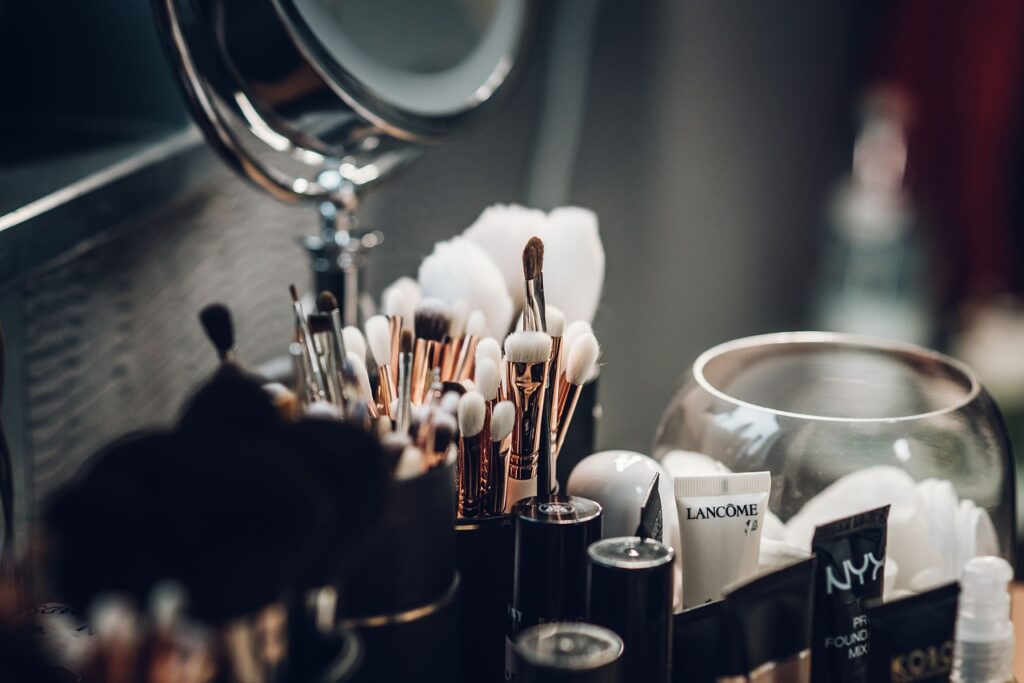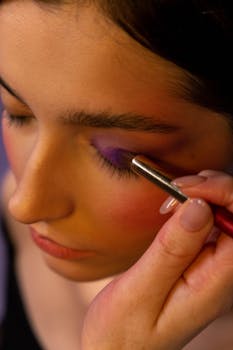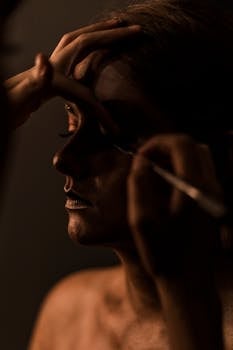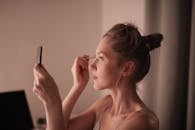Top 8 makeup artistry tips for beginners
1.Skin Preparation: The Foundation of Great Makeup for beginners
One of the most overlooked steps in makeup artistry is skin preparation. Properly prepared skin not only makes makeup application smoother but also improves its longevity and appearance. Start with a clean face. Use a gentle cleanser suitable for the skin type (dry, oily, combination) and follow up with a lightweight moisturizer. For clients with dry skin, opt for a rich moisturizer to create a smooth base; for oily skin, consider a mattifying moisturizer.
Next, apply a primer. Primers are essential because they create a barrier between the skin and makeup, helping it adhere better and last longer. For those with oily skin, a mattifying primer is ideal, while people with dry or normal skin might benefit from a hydrating or illuminating primer.
2. Tools of the Trade: Essential Makeup Tools for Beginners

Having the right tools can make a world of difference. Here are some beginner-friendly must-haves:
- Brushes: Invest in a good set of makeup brushes. Basic brushes should include a foundation brush, concealer brush, powder brush, blush brush, eyeshadow brush, and blending brush. Synthetic brushes work well with liquid products, while natural bristles are best for powders.
- Beauty Sponges: Sponges are versatile and can be used to blend foundation, concealer, or cream products. Dampen the sponge before use for a flawless, airbrushed finish.
- Eyelash Curler: This tool helps lift and curl lashes, making the eyes appear more open and bright.
- Tweezers and Brow Tools: Well-groomed brows frame the face. Use tweezers to pluck stray hairs and brow pencils or powders to fill in any gaps for a polished look
3. Understanding Color Theory: Building the Basics
Color theory is fundamental to makeup artistry because it influences how colors interact with different skin tones and eye colors. Here are some basics:
- Primary Colors: Red, blue, and yellow are the primary colors from which all others are derived.
- Secondary Colors: Created by mixing primary colors, these include green, purple, and orange.
- Complementary Colors: Colors that are opposite each other on the color wheel, like blue and orange, which are great for enhancing eye color in makeup.
Use complementary colors to make features stand out. For instance, if working with brown eyes, purples and warm golds can make them pop. Green eyes look striking with burgundy or reddish-brown tones, while blue eyes stand out with warm oranges or browns.
4. Mastering the Basics: Step-by-Step Application Guide for beginners

Starting with a simple makeup routine helps build confidence and control. Here’s a basic step-by-step application for beginners:
Step 1: Foundation
Foundation evens out the skin tone. Start by choosing a shade that closely matches the skin color. Test a few swatches on the jawline, and the shade that disappears is the best match. Apply foundation with a brush, sponge, or fingers, blending outward from the center of the face.
Step 2: Concealer
Use concealer to cover blemishes, dark circles, and redness. Choose a concealer slightly lighter than the skin tone for the under-eye area to brighten it up. Use a small brush or finger to dab and blend for a seamless finish.
Step 3: Setting Powder
Setting powder helps to lock in foundation and concealer, reducing shine and preventing creasing. Lightly dust powder on oily areas (typically the T-zone: forehead, nose, and chin) using a fluffy brush. Avoid over-applying to maintain a natural look.
Step 4: Blush and Bronzer
Blush adds a healthy flush to the cheeks, while bronzer gives warmth and dimension. Apply blush on the apples of the cheeks and blend upwards. Bronzer can be used under the cheekbones, around the forehead, and along the jawline to contour the face.
Step 5: Eyeshadow and Eyeliner
For beginners, stick to neutral shades for eyeshadow, which are easy to blend and versatile for day or night looks. Start with a light base color all over the lid, add a medium shade to the crease, and blend well. Eyeliner can be added to the upper lash line to define the eyes. Practice a steady hand, as eyeliner can be challenging initially.
Step 6: Mascara
Apply mascara to the top and bottom lashes to add volume and length. For extra lift, use an eyelash curler before applying mascara.
Step 7: Lip Color
Choose a lip color that complements the overall makeup. For a natural look, stick to nude or pink shades. For a bold look, reds or deep colors can add drama. Start with lip liner for precise application and finish with lipstick or gloss.
5. Blending: The Secret to Flawless Makeup

Blending is key to professional-looking makeup. Harsh lines between products or unblended edges can make makeup appear patchy or uneven. Whether it’s eyeshadow, blush, or foundation, blending creates a seamless transition and softens the overall look. Blending brushes and sponges are essential tools for achieving a flawless finish.
6. Practice Makes Perfect: Building Skills Over Time
Mastering makeup artistry takes practice and patience. Try different techniques, experiment with colors, and test products on yourself or friends to build your skills. Take photos to track your progress and learn from each attempt. Social media can also provide inspiration and tutorials, but remember that filters can sometimes create unrealistic expectations.
7. Sanitation: Keeping Things Clean
Hygiene is crucial in makeup artistry, especially if working on clients. Clean brushes and tools after each use to prevent bacteria buildup. Avoid double-dipping products and use clean applicators to maintain hygiene. Sanitizing tools and regularly replacing mascara and liquid products is vital for a safe, professional experience.
8. Developing Your Style: Exploring Your Creative Side
Once you’re comfortable with basic techniques, start experimenting with your unique style. Use bold colors, try graphic eyeliner, or explore special effects makeup. Makeup artistry is a form of self-expression, and as you grow, your unique style will begin to show in your work. Look to makeup artists who inspire you and practice new looks to expand your creative horizons.
Final Thoughts
Becoming skilled in makeup artistry as a beginner is a journey of constant learning and experimenting. Focus on building a strong foundation, mastering basic techniques, and gradually evolving your style. Don’t be afraid to make mistakes—each one is a learning experience that will improve your artistry. With practice and dedication, you’ll develop the confidence and skill to create beautiful, customized makeup looks for yourself or others.
